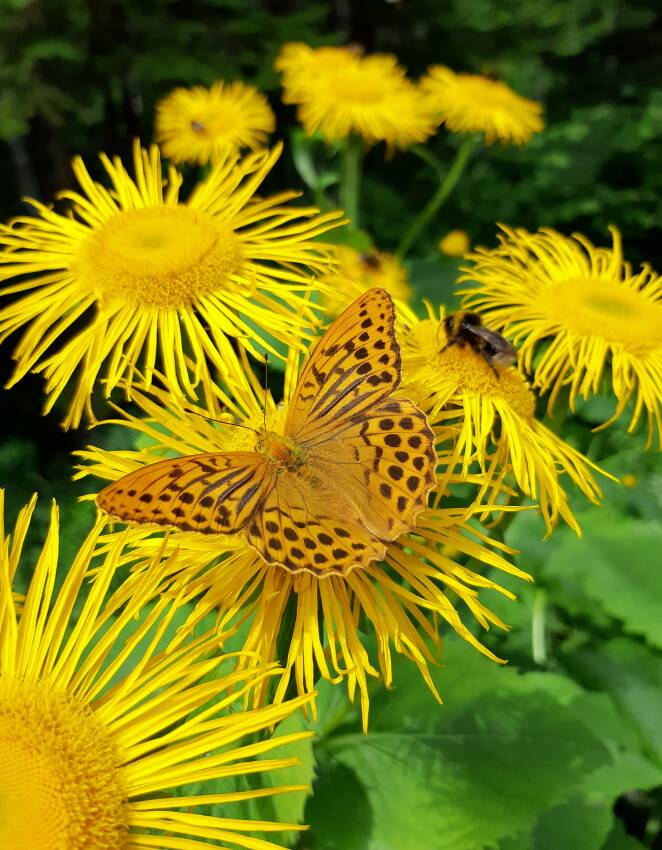Green in cities is even more important because nature reduces stress, makes us happier, healthier, and even makes social differences smaller. The collaboration between landscape architects and nurseries is a logical step towards more urban green and biodiversity.
The standard of living is known to improve when a city gets ‘greener’. Initiatives such as vertical forests, urban farming, and green roofs provide more urban green and cleaner air in cities.
read more

Nurseries and landscape architects
biodiversity within cities
join forces TO IMPROVE


What you can do in your own garden
The keyword to be of service to your garden is ‘mess’. It is essential to leave room for a bit of mishmash and chaos when it comes to our own greeneries. Of course there is also space for a neatly trimmed lawn and elegant beds, but the insects that keep our planet alive are very much helped with a pond, a pile of stones or a bit of weed, as it provides a great habitat for them. These messy places allow animals to reproduce and go through a full life cycle.
If we all take our responsibility - from nurserymen to landscape architects to citizens - we will be able to keep this planet a nice place to live. For us, and for the insects and the plants.
The role of landscape architects
Regarding the influence of landscape architects within this process, she proceeds: “They too have a huge role to play and I know they do so. I think architects that work on public contracts deliver very educational work. Many cities have landscape architects who understand that their work is more than just developing a selection of species.”
Luckily, Wojciech is one of those people who knows how to convince others of the importance of plants and trees. He thinks that the key to success regarding biodiversity does not come from using varieties of plants, but to use plants that are suitable for the conditions in which they grow. He also likes to convince others about the perks of certain plants and trees: “If I believe in a tree or a plant and I am aware of the advantages or problems that are associated with it, I am able to communicate these.” And if someone knows anything about the wonders that can be achieved with universal plants, it is Wojciech.
Landscape architects and growers play an essential role within these cities to improve the amount of green and biodiversity.
We discussed this matter with Agnieszka Żukowska (who has been involved in the nursery business for over twenty years) and Wojciech Grąbczewski, a very experienced nurseryman.


How we benefit from urban green
Agnieszka, a former director of the well-known exhibition Green Is Life, agrees with Wojciech on the importance of greenery in cities: “When we talk about the positive effects of trees and plants, people notice that they have a real impact on the climate, on their well-being and on the temperature in the city.” Trees and plants offer shade, which is essential for comfortable living circumstances within a city.
Keep educating people
She also shares something about the importance of ‘continuous education’ for citizens: “We must use arguments that are somehow measurable and translate these into tangible benefits. For example: convince them by pointing out that trees create a more comfortable temperature around them.”
Of course, nurserymen and landscape architects play a big role in this process. Investments need to be made, in both time and money, but very often this appears to be very valuable - luckily. Agnieszka elaborates: “We have to say loudly why it is worth planting trees, what are the benefits of the appearance of trees on the streets and also why it requires so much effort. Everyone has a role and should focus on what they know best. So, nurserymen should talk about - for example - which species and varieties would work under which conditions, and why ginkgo needs to be placed on spot A and black birch on spot B.”
Urban gardens that support biodiversity
Wojciech advises many people about the way they should arrange their gardens and urban greeneries, and always shares information about species that are more beneficial for bees and birds. “I recommend species that bloom and bear fruit. However, a lot of people still react with a bit of scowl when we say this, as they feel the birds make a mess.”
Protect what is good for the mind
In short, the importance of greenery around us should not be underestimated, as, for example, trees keep us from ‘going crazy’, in the words of Wojciech. We all know the effect of a nice walk through the park or forest, right? It’s a recurring insight during our interviews with these experts, but always accompanied with a warning: we have to protect our nature at all times.
Lifting the concrete sheets
Wojciech points out the importance of the amount of green in cities and what should be done to improve this: “We need to ‘de-concrete’ cities and lift the concrete ‘sheets’ on the ground, to let the earth breathe with the help of plants. Greenery helps a place come to life, and it’s important to take this into account when designing spaces in a city.”



Green in cities is even more important because nature reduces stress, makes us happier, healthier, and even makes social differences smaller. The collaboration between landscape architects and nurseries is a logical step towards more urban green and biodiversity.
The standard of living is known to improve when a city gets ‘greener’. Initiatives such as vertical forests, urban farming, and green roofs provide more urban green and cleaner air in cities.
biodiversity within cities
Nurseries and landscape architects JOIN FORCES TO IMPROVE

The keyword to be of service to your garden is ‘mess’. It is essential to leave room for a bit of mishmash and chaos when it comes to our own greeneries. Of course there is also space for a neatly trimmed lawn and elegant beds, but the insects that keep our planet alive are very much helped with a pond, a pile of stones or a bit of weed, as it provides a great habitat for them. These messy places allow animals to reproduce and go through a full life cycle.
If we all take our responsibility - from nurserymen to landscape architects to citizens - we will be able to keep this planet a nice place to live. For us, and for the insects and the plants.
What you can do in your own garden
Regarding the influence of landscape architects within this process, she proceeds: “They too have a huge role to play and I know they do so. I think architects that work on public contracts deliver very educational work. Many cities have landscape architects who understand that their work is more than just developing a selection of species.”
Luckily, Wojciech is one of those people who knows how to convince others of the importance of plants and trees. He thinks that the key to success regarding biodiversity does not come from using varieties of plants, but to use plants that are suitable for the conditions in which they grow. He also likes to convince others about the perks of certain plants and trees: “If I believe in a tree or a plant and I am aware of the advantages or problems that are associated with it, I am able to communicate these.” And if someone knows anything about the wonders that can be achieved with universal plants, it is Wojciech.
The role of landscape architects

She also shares something about the importance of ‘continuous education’ for citizens: “We must use arguments that are somehow measurable and translate these into tangible benefits. For example: convince them by pointing out that trees create a more comfortable temperature around them.”
Of course, nurserymen and landscape architects play a big role in this process. Investments need to be made, in both time and money, but very often this appears to be very valuable - luckily. Agnieszka elaborates: “We have to say loudly why it is worth planting trees, what are the benefits of the appearance of trees on the streets and also why it requires so much effort. Everyone has a role and should focus on what they know best. So, nurserymen should talk about - for example - which species and varieties would work under which conditions, and why ginkgo needs to be placed on spot A and black birch on spot B.”
Keep educating people
How we benefit from urban green
Agnieszka, a former director of the well-known exhibition Green Is Life, agrees with Wojciech on the importance of greenery in cities: “When we talk about the positive effects of trees and plants, people notice that they have a real impact on the climate, on their well-being and on the temperature in the city.” Trees and plants offer shade, which is essential for comfortable living circumstances within a city.
Urban gardens that support biodiversity
Wojciech advises many people about the way they should arrange their gardens and urban greeneries, and always shares information about species that are more beneficial for bees and birds. “I recommend species that bloom and bear fruit. However, a lot of people still react with a bit of scowl when we say this, as they feel the birds make a mess.”
Protect what is good for the mind
In short, the importance of greenery around us should not be underestimated, as, for example, trees keep us from ‘going crazy’, in the words of Wojciech. We all know the effect of a nice walk through the park or forest, right? It’s a recurring insight during our interviews with these experts, but always accompanied with a warning: we have to protect our nature at all times.
Lifting the concrete sheets
Wojciech points out the importance of the amount of green in cities and what should be done to improve this: “We need to ‘de-concrete’ cities and lift the concrete ‘sheets’ on the ground, to let the earth breathe with the help of plants. Greenery helps a place come to life, and it’s important to take this into account when designing spaces in a city.”

Landscape architects and growers play an essential role within these cities to improve the amount of green and biodiversity.
We discussed this matter with Agnieszka Żukowska (who has been involved in the nursery business for over twenty years) and Wojciech Grąbczewski, a very experienced nurseryman.